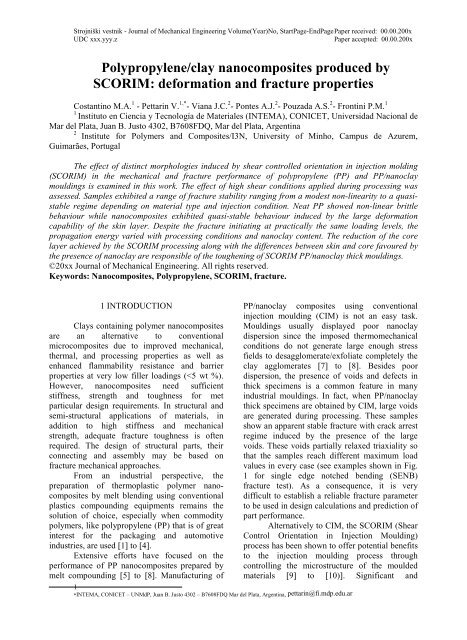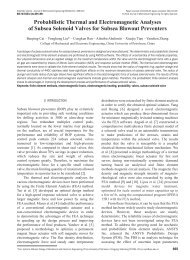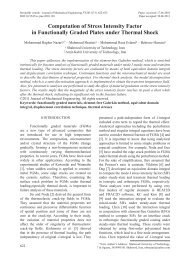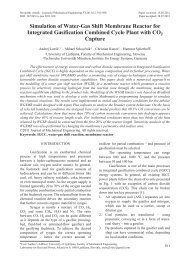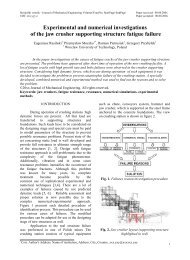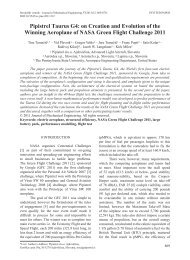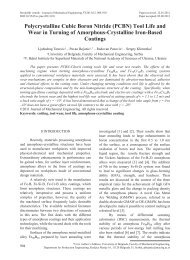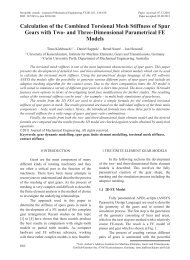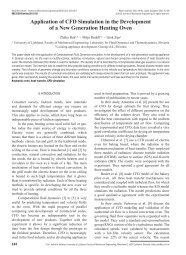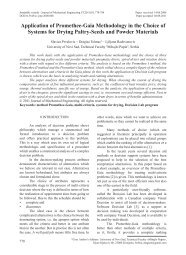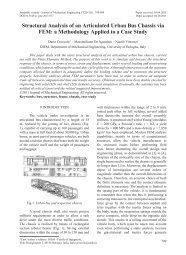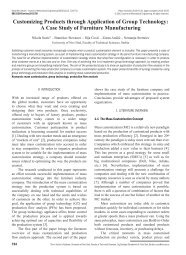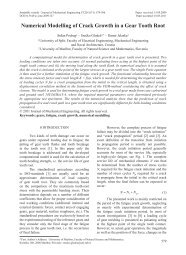Polypropylene/clay nanocomposites produced by SCORIM
Polypropylene/clay nanocomposites produced by SCORIM
Polypropylene/clay nanocomposites produced by SCORIM
You also want an ePaper? Increase the reach of your titles
YUMPU automatically turns print PDFs into web optimized ePapers that Google loves.
Strojniški vestnik - Journal of Mechanical Engineering Volume(Year)No, StartPage-EndPage Paper received: 00.00.200x<br />
UDC xxx.yyy.z<br />
Paper accepted: 00.00.200x<br />
<strong>Polypropylene</strong>/<strong>clay</strong> <strong>nanocomposites</strong> <strong>produced</strong> <strong>by</strong><br />
<strong>SCORIM</strong>: deformation and fracture properties<br />
Costantino M.A. 1 - Pettarin V. 1,* - Viana J.C. 2 - Pontes A.J. 2 - Pouzada A.S. 2 - Frontini P.M. 1<br />
1<br />
Instituto en Ciencia y Tecnología de Materiales (INTEMA), CONICET, Universidad Nacional de<br />
Mar del Plata, Juan B. Justo 4302, B7608FDQ, Mar del Plata, Argentina<br />
2<br />
Institute for Polymers and Composites/I3N, University of Minho, Campus de Azurem,<br />
Guimarães, Portugal<br />
The effect of distinct morphologies induced <strong>by</strong> shear controlled orientation in injection molding<br />
(<strong>SCORIM</strong>) in the mechanical and fracture performance of polypropylene (PP) and PP/nano<strong>clay</strong><br />
mouldings is examined in this work. The effect of high shear conditions applied during processing was<br />
assessed. Samples exhibited a range of fracture stability ranging from a modest non-linearity to a quasistable<br />
regime depending on material type and injection condition. Neat PP showed non-linear brittle<br />
behaviour while <strong>nanocomposites</strong> exhibited quasi-stable behaviour induced <strong>by</strong> the large deformation<br />
capability of the skin layer. Despite the fracture initiating at practically the same loading levels, the<br />
propagation energy varied with processing conditions and nano<strong>clay</strong> content. The reduction of the core<br />
layer achieved <strong>by</strong> the <strong>SCORIM</strong> processing along with the differences between skin and core favoured <strong>by</strong><br />
the presence of nano<strong>clay</strong> are responsible of the toughening of <strong>SCORIM</strong> PP/nano<strong>clay</strong> thick mouldings.<br />
©20xx Journal of Mechanical Engineering. All rights reserved.<br />
Keywords: Nanocomposites, <strong>Polypropylene</strong>, <strong>SCORIM</strong>, fracture.<br />
1 INTRODUCTION<br />
Clays containing polymer <strong>nanocomposites</strong><br />
are an alternative to conventional<br />
microcomposites due to improved mechanical,<br />
thermal, and processing properties as well as<br />
enhanced flammability resistance and barrier<br />
properties at very low filler loadings (
Strojniški vestnik - Journal of Mechanical Engineering Volume(Year)No, StartPage-EndPage<br />
simultaneous improvements on the stiffness,<br />
strength and toughness, the better alignment of<br />
fillers, fibres and macromolecules, the moulding<br />
to closer tolerances, the enhancement of<br />
dimensional stability and reproducibility, the<br />
improvement in the aesthetic of the parts, the<br />
elimination of microcracks and voids in the<br />
mouldings, and the elimination of internal weld<br />
lines and sink marks were reported for PP and<br />
other semicrystalline polymers [11]. However,<br />
little research effort has been devoted to the<br />
moulding of polymer <strong>nanocomposites</strong> <strong>by</strong><br />
<strong>SCORIM</strong>. In fact, the high shear levels applied<br />
during <strong>SCORIM</strong> is expected to lead to a better inprocess<br />
dispersion and orientation of the fillers in<br />
the nanocomposite.<br />
Fig. 1. Load vs. displacement curves for<br />
equivalent PP/nano<strong>clay</strong> mouldings processed <strong>by</strong><br />
CIM. Differences in the flexural loaddisplacement<br />
curves for equivalent fracture<br />
samples are clearly seen<br />
In addition, there are previous promising<br />
findings on the use of <strong>SCORIM</strong> to manufacture<br />
PP/nano<strong>clay</strong> composites [12-15], which have<br />
encouraged us to conduct the present research.<br />
Our results showed that for PP, which is a<br />
semicrystalline polymer, nano<strong>clay</strong> acts as<br />
morphology director, and the concomitant use of<br />
<strong>SCORIM</strong> and nano<strong>clay</strong>s results in distinct<br />
morphologies [16]. Nano<strong>clay</strong>s act as α− and γ-<br />
phases nucleating agent, increasing the degree of<br />
epitaxiality in the skin of the PP/nano<strong>clay</strong><br />
mouldings. When compared with CIM, <strong>SCORIM</strong><br />
results in a higher degree of crystallinity of the<br />
skin layer. <strong>SCORIM</strong> mouldings exhibit a welldefined<br />
“shear”-core structure: a centre-core<br />
which occupies less space in comparison with<br />
2<br />
typical CIM moulded parts and a larger shear<br />
zone. When the nano<strong>clay</strong> was added, an<br />
interesting multilayered structure occupies more<br />
than two times the thickness of the shear zone of<br />
the PP/nano<strong>clay</strong> pieces, i.e. there is even less<br />
core. It is then expected that these changes will be<br />
reflected in the mechanical and fracture properties<br />
of the mouldings.<br />
The present work investigates the effect of<br />
distinct morphologies induced <strong>by</strong> <strong>SCORIM</strong> in the<br />
mechanical and fracture performance of<br />
PP/nano<strong>clay</strong> mouldings.<br />
2 MATERIALS AND METHODS<br />
2.1. Sample manufacturing and<br />
microstructural characteristics<br />
Compounds were based on Domolen<br />
1100L homopolymer PP and 6, 10 and 14% of P-<br />
802 Nanocor masterbatch of 50%PP/50%<br />
nano<strong>clay</strong> (MB). The materials were first blended<br />
in a drum rotating at 60 rpm. Double edge gated<br />
parallelepiped bars of 130×13×8 mm were<br />
injection moulded with a Ferromatik Milacron K-<br />
85A injection moulding machine, equipped with a<br />
<strong>SCORIM</strong> mould with manifold and hydraulic<br />
system, which manipulates the melt inside the<br />
mould impression. The hydraulic pistons<br />
operating in various modes displace the melt<br />
during the holding phase of the moulding process,<br />
shearing the solid/melt interface and aligning<br />
fillers and polymer molecules.<br />
Table 1: Variable injection processing set-up for<br />
<strong>SCORIM</strong><br />
Run Stroke<br />
time<br />
Melt<br />
temperature<br />
Stroke<br />
number<br />
1 1 (1s) 1 (200°C) 1 (3)<br />
2 1 2 (220°C) 2 (7)<br />
3 1 3 (240°C) 3 (13)<br />
4 2 (2s) 2 3<br />
5 2 3 1<br />
6 2 1 2<br />
7 3 (3s) 3 2<br />
8 3 1 3<br />
9 3 2 1<br />
The moulding programme was defined<br />
according to a design of experiments (DOE)<br />
based on a 3-level factorial array (Table 1). The<br />
processing parameters considered were melt<br />
temperature (200, 220 and 240°C), stroke time<br />
Costantino M.A. - Pettarin V.- Viana J.C.- Pontes A.J.- Pouzada A.S.- Frontini P.M.
Strojniški vestnik - Journal of Mechanical Engineering Volume(Year)No, StartPage-EndPage<br />
(i.e., piston movement time of 1, 2 and 3s) and<br />
stroke number (i.e., number of piston movements:<br />
3, 7 and 13). The other injection moulding<br />
parameters were kept constant: mould<br />
temperature of 30°C, injection pressure of 15<br />
MPa, injection velocity of 10 mm/s, holding<br />
pressure of 5.3 MPa and cooling time of 30 s.<br />
Details are as reported in [16].<br />
A complete characterization of the<br />
microstructure of these mouldings was already<br />
reported [16]. An intercalated PP/nano<strong>clay</strong><br />
structure was obtained with an intergallery space<br />
of 13.4 nm for all systems, calculated from the<br />
(001) peak of X-ray diffraction patterns using the<br />
λ = 2d<br />
Bragg’s law (<br />
001<br />
sinθ001<br />
). Several<br />
characteristics of PP morphology were analyzed,<br />
and two of them are crucial: the degree of<br />
orientation of α-PP crystallites and the amount of<br />
γ-PP phase in the skin layer. The degree of<br />
orientation of α-PP was quantified <strong>by</strong> means of<br />
A<br />
110<br />
= Iα( 110) ( Iα( 110) + Iα( 111) + Iα( 131) + ( 041)<br />
), which<br />
gives an indication of the orientation roughly<br />
parallel to the c-axis of the crystallites which in<br />
this case corresponds to the flow direction in the<br />
injected samples. I i is the i peak height of XRD<br />
after background subtraction. It was found a high<br />
increase of the Iα (040) /Iα (110) ratio for the<br />
<strong>SCORIM</strong> PP-nano<strong>clay</strong> samples. This indicates<br />
that in <strong>SCORIM</strong> mouldings the nano<strong>clay</strong> induced<br />
the orientation of the α crystalline-phase of PP in<br />
the (040) direction – i.e. increase of degree of<br />
epitaxiality [17] – and imparting a low level of<br />
crystalline phase orientation in the flow direction.<br />
Values of A 110 index are presented in Table 2.<br />
Regarding the effect of the <strong>SCORIM</strong> processing<br />
conditions on the morphology development, it<br />
was found that A 110 increases with high shearing,<br />
and decreases for low shearing and low melt<br />
temperatures.<br />
The content of crystalline γ-phase was<br />
evaluated <strong>by</strong> means of G = Iγ<br />
( 117)<br />
( Iγ<br />
(1117)<br />
+ Iα<br />
(130)<br />
),<br />
also listed in Table 2. It was seen that the amount<br />
of γ increases with MB content in an asymptotic<br />
way to a maximum value, in agreement with<br />
other authors who claimed that nano<strong>clay</strong> [18-22]<br />
and <strong>SCORIM</strong> [23] promote the formation of γ-<br />
phase PP crystallites. The nano<strong>clay</strong> changes the<br />
equilibrium state of the polymer (conformation)<br />
and it provides favorable sites for possible<br />
epitaxial growth of γ-phase because the lattice<br />
3<br />
mismatch is less than 10% [19]. Moreover, γ<br />
crystals are nucleated and grow epitaxiality on the<br />
lateral (010) faces of the α crystal [24] and appear<br />
to be favored <strong>by</strong>, or linked to, the absence of<br />
chain folding [25]. The mobility of the PP-MA<br />
matrix is significantly reduced in the presence of<br />
maleic anhydride grafting in the main chain<br />
(present in MB), which causes a lowering of<br />
chain folding. Again, in the presence of <strong>clay</strong><br />
particles in polymer <strong>nanocomposites</strong>, the<br />
movement of polymer chains inside the <strong>clay</strong><br />
particles is restricted. The correlation length of<br />
the <strong>clay</strong> particles is roughly the same as that of<br />
the radius of gyration of the matrix. Thus, the<br />
formation of the γ-phase is enhanced in the<br />
presence of <strong>clay</strong> particles [21-22].<br />
Table 2: Orientation indexes and γ-PP content for<br />
<strong>SCORIM</strong> samples<br />
Run A 110 (PP/MB-6)<br />
1 0.158<br />
2 0.165<br />
3 0.186<br />
4 0.187<br />
5 0.194<br />
6 0.200<br />
7 0.189<br />
8 0.190<br />
9 0.189<br />
Material G<br />
PP 0<br />
PP/MB-6 0.48<br />
PP/MB-10 0.52<br />
PP/MB-14 0.55<br />
For more information about macro and<br />
microstructure of these moldings readers are<br />
referred to [16].<br />
2.2 Mechanical performance<br />
The yield stress of the material in the<br />
mouldings was determined in compression using<br />
prismatic specimens of rectangular cross section<br />
(h=10 mm, h/L=1.5 h, and L being the height and<br />
the width of the sample). These samples were cut<br />
out from moulded parts. Smooth and parallel<br />
Non-conventional injected polypropylene-nano<strong>clay</strong> composites: mechanical properties and fracture
Strojniški vestnik - Journal of Mechanical Engineering Volume(Year)No, StartPage-EndPage<br />
faces were obtained <strong>by</strong> machining. The tests were<br />
performed using an Instron 4467 universal testing<br />
machine, at 1 mm/min and room temperature. To<br />
elude the eventual influence of voids developed<br />
during injection moulding, the starting of the<br />
plastic domain, i.e. the start of yielding, was<br />
considered as the end of the linear portion of the<br />
stress-strain plot [26]. The flexural modulus was<br />
measured according to the ASTM D 790-03<br />
standard, at 5 mm/min and room temperature. At<br />
least five samples of each processing condition<br />
were tested.<br />
2.3. Fracture Characterization<br />
The fracture characterization was<br />
performed on single edge notched specimens<br />
(SENB) deformed in 3-point bending at room<br />
temperature at constant crosshead velocity of<br />
5 mm/min in the Instron 4467. Specimens with<br />
span, S, and width, W, of 52 and 13 mm,<br />
respectively, were prepared <strong>by</strong> machining from<br />
the injected bars. Sharp notches were introduced<br />
using a Notchvis Ceast machine with a sharp fly<br />
cutter (tip radius less than 12 µm) to reach a<br />
crack-to-depth ratio (a/W) equal to 0.5.<br />
The fracture initiation was evaluated from<br />
the Critical Stress Intensity Factor in Mode I, K IC ,<br />
(Eq. 4) using load-line displacement plots and the<br />
crack length,<br />
P<br />
K IC<br />
= f ( a / W )<br />
(1)<br />
1/<br />
2<br />
BW<br />
where P is the load, B is the sample<br />
breadth, W is the sample width, a is the crack<br />
length and f(a/W) is a dimensionless function of<br />
a/W according to ASTM D 5045.<br />
Due to the non-linearity of the loaddisplacement<br />
plots, P was determined at the<br />
intersection of a straight line with a compliance of<br />
5% greater than that of the initial compliance and<br />
the load-displacement trace. In every case the<br />
geometry validity requirements were met<br />
according to [27]:<br />
⎛ K ⎞<br />
B,<br />
a,(<br />
W − a)<br />
≥ 2.5 ⎜ ⎟ (2)<br />
⎝ σ<br />
y ⎠<br />
The value of the J integral was computed<br />
from:<br />
2 U<br />
J = (3)<br />
B(<br />
W − a)<br />
2<br />
The energy, U, was computed <strong>by</strong> the<br />
integration of the load-displacement traces up to<br />
the maximum load point (J max ) and up to the<br />
instability load point (J c ) [28]. This value of J was<br />
computed to designate the point of unstable<br />
fracture, or loss of structural integrity in samples<br />
displaying quasi-stable crack propagation.<br />
3 RESULTS AND DISCUSSION<br />
3.1. Deformation performance<br />
The yield stress of PP <strong>nanocomposites</strong><br />
resulted slightly larger than neat PP, but almost<br />
not varying with the nano<strong>clay</strong> content (Fig. 2).<br />
The trends reported in the literature are<br />
contradictory, reporting either an increase or a<br />
decrease in properties with addition of nano<strong>clay</strong><br />
[29].<br />
Fig. 2. Mechanical properties of PP<br />
<strong>nanocomposites</strong><br />
A quite significant increase in the flexural<br />
modulus of <strong>nanocomposites</strong> in comparison with<br />
the neat PP was also found, in the order of 35-<br />
40% (Fig. 2). From theoretical predictions using<br />
the Mori-Tanaka composite micromechanical<br />
model, it is possible to estimate an increase of the<br />
elastic modulus of PP with 3-6% of nano<strong>clay</strong> of<br />
the same order [30]. For lower incorporation of<br />
nano<strong>clay</strong>, in the range between 1 and 6%, the<br />
variations of the elastic modulus are negligible,<br />
an increasing being observed thereafter. Besides<br />
the amount of nano<strong>clay</strong>, the intercalated nano<strong>clay</strong><br />
morphology may also restrict the mobility of the<br />
polymer chains and contribute to the<br />
improvement of the modulus. Furthermore, in<br />
flexural tests, the mechanical response is<br />
governed <strong>by</strong> the most exterior layer, i.e. at the<br />
skin of injected samples. In these samples, the PP<br />
4<br />
Costantino M.A. - Pettarin V.- Viana J.C.- Pontes A.J.- Pouzada A.S.- Frontini P.M.
Strojniški vestnik - Journal of Mechanical Engineering Volume(Year)No, StartPage-EndPage<br />
microstructure of the skin layer changed with the<br />
addition of nano<strong>clay</strong>, but the microstructural<br />
features are independent of the nano<strong>clay</strong> content<br />
[16]. Due to the segregation effect of the nano<br />
<strong>clay</strong> in the skin, it seems that the effective content<br />
of nano<strong>clay</strong> is similar irrespectively of MB<br />
concentration [16], and hence the modulus. This<br />
can be corroborated <strong>by</strong> observing in TEM the<br />
skin zone (as in Fig 3). A marked nano<strong>clay</strong><br />
orientation along the flow direction in the skin<br />
layer of the injected samples is visible, but<br />
complete exfoliation cannot be observed neither<br />
in the skin or the core zones.<br />
(a)<br />
(b)<br />
Fig. 4. Fracture load vs displacement curves for<br />
<strong>SCORIM</strong> injected PP and PP/MB-6 respectively<br />
Fig. 3. TEM images of PP/MB-5 (a) skin (b) core<br />
3.2. Fracture Performance<br />
The samples exhibited different fracture<br />
stabilities ranging from a modest non-linearity to<br />
a quasi-stable regime. The fracture regime<br />
depends on the type of material and the injection<br />
moulding conditions (Fig 4).<br />
PP shows a non-linear behaviour and<br />
unstable brittle fracture after reaching the<br />
maximum load. The load–displacement curves<br />
dropped to zero immediately after reaching the<br />
maximum load with relatively short displacement<br />
(Fig 4).<br />
5<br />
The composite mouldings <strong>produced</strong> <strong>by</strong><br />
<strong>SCORIM</strong> were of acceptable quality and showed<br />
various load-displacement patterns. Most of the<br />
samples exhibited a quasi-stable behaviour: the<br />
load increased non-linearly, and then it kept<br />
constant up to a certain displacement when a<br />
drastic drop occurred (Fig 4). Moreover, in most<br />
of the samples a large deformation of the skin<br />
layer was observed (Fig 5). It should be<br />
mentioned here that this ‘skin effect’ is<br />
characterized <strong>by</strong> tail instability load-displacement<br />
curves that were already reported for PP based<br />
systems [31-32]. This large deformation of the<br />
skin layer can be related to the high level of<br />
molecular and nano<strong>clay</strong> orientation (Fig 3) that<br />
favours the sliding of the macromolecules<br />
(fostered <strong>by</strong> the oriented nano<strong>clay</strong>s) thus<br />
improving the deformation capability. In fact, we<br />
must point out that the occurrence of necking is<br />
likely a combined effect of: the skin/core ratio,<br />
the skin orientation level, and possibly the<br />
morphology rearrangement in the skin region<br />
Non-conventional injected polypropylene-nano<strong>clay</strong> composites: mechanical properties and fracture
Strojniški vestnik - Journal of Mechanical Engineering Volume(Year)No, StartPage-EndPage<br />
under different loading directions, influenced also<br />
<strong>by</strong> the heat evolution and the dissipation<br />
processes. Since <strong>SCORIM</strong> induces a thicker<br />
multi-layered skin in the PP/nano<strong>clay</strong> mouldings<br />
[16], the ‘skin effect’ is favoured. This<br />
phenomenon leads to differences in the loaddisplacement<br />
curves, promoting a more stable<br />
crack propagation followed <strong>by</strong> a necking phase<br />
with much larger extension [8, 32-33]. When<br />
voids appeared at the fracture surface, they inhibit<br />
or in-stabilize the ‘skin-effect’ due to stress<br />
concentration.<br />
Table 2: Initiation fracture parameters of the<br />
mouldings<br />
K IC<br />
MPa.m 1/2<br />
J max<br />
N/mm<br />
Run PP PP/MB-6 PP PP/MB-6<br />
1 1.4±0.2 1.6±0.3 6.7±1 10.25±3.7<br />
2 1.45±0.3 1.5±0.3 6±1 7±0.8<br />
3 1.25±0.1 1.3±0.2 7±1 5±2<br />
4 1.5±0.3 1.6±0.1 11±8.7 7.75±1<br />
5 1.3±0.2 1.4±0.3 7.2±1.6 5±1.2<br />
6 1.3±0.1 1.7±0.2 8.4±1.9 7.5±2<br />
7 1.3±0.2 1.6±0.1 8.8±3.8 7.3±1.5<br />
8 1.6±0.4 1.8±0.1 8.4±2.1 11±2.5<br />
9 1.2±0.1 1.4±0.3 6±1.2 6.5±2<br />
Table 3: J c data for the mouldings<br />
Fig. 5. PP/MB-6 sample after fracture test. Note<br />
the highly deformed skin without fracture<br />
For these PP/nano<strong>clay</strong> composites, small<br />
differences were displayed <strong>by</strong> K IC , and J max<br />
(which are related to the fracture initiation)<br />
(Table 2) but large differences in J c (that is<br />
related to the fracture propagation) were found<br />
(Table 3), in comparison with neat PP samples.<br />
Replicas of each condition show significant<br />
scatter originated <strong>by</strong> a combination of different<br />
causes. The differences observed are typical of<br />
semicrystalline polymers injection mouldings that<br />
are influenced <strong>by</strong> microstructural parameters,<br />
which include crystalline structure, degree of<br />
crystallinity, supermolecular structure, and skincore<br />
configuration [34]. Besides, PP systems are<br />
considered to be in the ductile-to-brittle transition<br />
regime at room temperature, which implies a<br />
larger scatter [35] due to dissimilar contributions<br />
of the plastics melt flow and the stable crack<br />
growth in different specimens of the same set.<br />
N/mm<br />
Run<br />
Samples with no<br />
All samples<br />
visible defects<br />
PP PP/MB-6 PP PP/MB-6<br />
1 6.7±1 58.2±35.9 6.7±1 94.5±7.8<br />
2 6±1 20±13.7 6±1 *<br />
3 7±1 54±25.8 7±1 65.5±3<br />
4 11±8.7 10.8±3.5 7.2±0.9 8.3±1.2<br />
5 7.2±1.6 14.8±8 6.5±0.6 23.5±2.1<br />
6 8.4±1.9 10.4±3.3 8.4±1.9 10.4±3.2<br />
7 8.8±3.8 11.3±4.7 7±0.01 9±1.7<br />
8 8.4±2.1 40.4±35.4 8.4±2.1 78.5±13<br />
9 6±1.2 16.4±11.9 6±1.2 *<br />
The addition of nano<strong>clay</strong> improved the<br />
fracture performance of the <strong>SCORIM</strong><br />
PP/nano<strong>clay</strong> samples thanks to the differences<br />
induced <strong>by</strong> the fillers in the microstructure: as we<br />
stated previously [16], they refine the crystal<br />
structure, and orientate α-PP crystals promoting<br />
the epitaxial growth of the γ-phase which is<br />
beneficial to improve toughness [18]. Let’s take<br />
an insight in this last point. Several studies have<br />
demonstrated the coexistence and concurrent<br />
growth of α and γ lamellae, and that there is a<br />
continual decrease of lamellar thickness with γ<br />
content [36]. It also has been shown that<br />
toughness decreases linearly with the reciprocal<br />
value of lamellar thickness [37]. Moreover,<br />
J c<br />
6<br />
Costantino M.A. - Pettarin V.- Viana J.C.- Pontes A.J.- Pouzada A.S.- Frontini P.M.
Strojniški vestnik - Journal of Mechanical Engineering Volume(Year)No, StartPage-EndPage<br />
polypropylenes with high contents of γ phase has<br />
been shown to present a typical behavior of stiffplastic<br />
materials, with a high value of the elastic<br />
modulus but with a high ductility [38]. Therefore,<br />
it is concluded that the generated γ-phase in the<br />
skin of the samples, induce a large-scale plastic<br />
deformation of the skin with consequent tearing<br />
of matrix ligaments leading to fibrillation, and<br />
enhancing toughness.<br />
The best global results (skin effect with<br />
high value of J and acceptable reproducibility)<br />
were achieved with processing conditions that<br />
imply low injection temperature and shear.<br />
The ANOVA analysis of results indicates<br />
that the increment of the shear level (higher<br />
stroke number and longer time) leads to a<br />
decrease in J c . The correlation of these results<br />
with the results of the processing induced<br />
morphology [16] seems to indicate that the most<br />
relevant morphology features is the level of<br />
orientation at the skin in the flow direction:<br />
higher orientation levels induce a lower toughness<br />
(see Fig. 6), keeping in mind that higher<br />
orientation implies higher γ-PP content.<br />
Jc (N/mm)<br />
100<br />
7<br />
80<br />
60<br />
40<br />
20<br />
0<br />
0,16 0,17 0,18 0,19 0,20<br />
A 110<br />
Fig. 6. Influence of skin orientation of PP<br />
crystallites (A 110 ) in toughness of PP/MB-6<br />
CONCLUSIONS<br />
The characterization of PP/nano<strong>clay</strong><br />
mouldings <strong>produced</strong> <strong>by</strong> <strong>SCORIM</strong> leads to the<br />
following conclusions:<br />
The <strong>SCORIM</strong> mouldings of neat PP<br />
showed a non-linear brittle behaviour, whereas<br />
PP <strong>nanocomposites</strong> exhibited a quasi-stable<br />
behaviour induced <strong>by</strong> a larger deformability of<br />
the skin layer. Despite the fracture initiating at<br />
practically the same loading levels, the overall<br />
crack propagation energy values varied as<br />
function of the processing conditions.<br />
The statistical analysis indicates that the<br />
reduction of the core size, achieved in the<br />
<strong>SCORIM</strong> processing, along with the differences<br />
between skin (or shear zone) and core zones, and<br />
favoured <strong>by</strong> the presence of the nano<strong>clay</strong>s, are<br />
responsible for the improvement in the<br />
tougheness of the <strong>SCORIM</strong> PP/nano<strong>clay</strong> thick<br />
samples.<br />
REFERENCES<br />
[1] Alexandre, M. and P. Dubois (2000).<br />
Polymer-layered silicate <strong>nanocomposites</strong>:<br />
preparation, properties and uses of a new<br />
class of materials. Materials Science and<br />
Engineering: R: Reports, vol. 28, no. 1-2, p.<br />
1-63.<br />
[2] Manias, E., Touny, A., Wu, L., Strawhecker,<br />
K., Lu, B. and Chung, T.C. (2001).<br />
<strong>Polypropylene</strong> / Montmorillonite<br />
Nanocomposites. Review of the Synthetic<br />
Routes and Materials Properties. Chemistry<br />
of Materials, vol. 13, no. 10, p. 3516-3523.<br />
[3] Paul, D. R. and L. M. Robeson (2008).<br />
Polymer nanotechnology: Nanocomposites.<br />
Polymer, vol. 49, no. 15, p. 3187-3204.<br />
[4] Ciardelli, F., Coiai, S., Passaglia, E., Pucci,<br />
A. and Ruggeri, G. (2008). Nanocomposites<br />
based on polyolefins and functional<br />
thermoplastic materials. Polymer<br />
International, vol. 57, no. 6, p. 805-836.<br />
[5] Li, J., Ton-That, M.T., Leelapornpisit, W.,<br />
Utracki, L.A. (2007). Melt compounding of<br />
polypropylene-based <strong>clay</strong> <strong>nanocomposites</strong>.<br />
Polymer Engineering and Science, vol. 47, p.<br />
1447.<br />
[6] Peltola, P., Valipakka, E., Vuorinen, J.,<br />
Syrjala, S., Hanhi, K. (2006). Effect of<br />
rotational speed of twin screw extruder on<br />
the microstructure and rheological and<br />
mechanical properties of nano<strong>clay</strong>-reinforced<br />
polypropylene <strong>nanocomposites</strong> Polymer<br />
Engineering and Science, vol. 46, p. 995.<br />
[7] Pettarin, V., Viau, G., Fasce, L., Viana, J. C.,<br />
Pontes, A. J., Frontini, P. M. and Pouzada,<br />
A. S. (2012). Uni- and biaxial impact<br />
behavior of double-gated nano<strong>clay</strong>-<br />
Non-conventional injected polypropylene-nano<strong>clay</strong> composites: mechanical properties and fracture
Strojniški vestnik - Journal of Mechanical Engineering Volume(Year)No, StartPage-EndPage<br />
reinforced polypropylene injection moldings.<br />
Polymer Engineering and Science, in press.<br />
[8] Pettarin, V., Brun, F., Viana, J.C., Pouzada,<br />
A.S. and Frontini, P.M. (2013). Toughness<br />
distribution in complex PP/nano<strong>clay</strong> injected<br />
mouldings. Composites Science &<br />
Technology, vol. 74, p. 28-36.<br />
[9] Kalay, G. and Bevis M.J. (1997). Processing<br />
and physical property relationships in<br />
injection-molded isotactic polypropylene.<br />
2. Morphology and crystallinity. Journal of<br />
Polymer Science Part B: Polymer Physics,<br />
vol. 35, no. 2, p. 265-291.<br />
[10] Kalay, G. and Bevis M.J. (1997). Processing<br />
and physical property relationships in<br />
injection-molded isotactic polypropylene.<br />
1. Mechanical properties, Journal of Polymer<br />
Science Part B: Polymer Physics, vol. 35, no.<br />
2, p. 241–263.<br />
[11] Kikuchi A., Coulter J.P. and Angstadt D.C.<br />
(2002). Polymer Melt Manipulation and In-<br />
Process Morphology Control during Molding<br />
Processes: A Review. Journal of Injection<br />
Molding Technology, vol. 6, no. 2, p. 91.<br />
[12] Bilewicz, M., Viana, J.C., Cunha, A.M. and<br />
Dobrzański, L. A. (2006). Morphology<br />
diversity and mechanical response of<br />
injection moulded polymer <strong>nanocomposites</strong><br />
and polymer-polymer composites. Journal of<br />
Achievements in Materials and<br />
Manufacturing Engineering vol. 15, no. 1-2,<br />
p. 156-165.<br />
[13] Bilewicz, M., Viana, J.C. and Dobrzański,<br />
L.A. (2006). Self reinforced polymerpolymer<br />
composites. Journal of<br />
Achievements in Materials and<br />
Manufacturing Engineering, vol. 24, no. 2, p.<br />
43-46.<br />
[14] Bilewicz, M., Viana, J.C. and Dobrzański,<br />
L.A. (2008). Development of microstructure<br />
affected <strong>by</strong> in-mould manipulation in<br />
polymer composites and <strong>nanocomposites</strong>.<br />
Journal of Achievements in Materials and<br />
Manufacturing Engineering, vol. 31, no. 1, p.<br />
71-76.<br />
[15] Bilewicz, M., Viana, J.C. and Dobrzański,<br />
L.A. (2008). Polymer composite<br />
strengthening <strong>by</strong> developed injection<br />
moulding technique. Archives of Materials<br />
Science and Engineering vol. 30, no. 2, p.<br />
69-72.<br />
8<br />
[16] Costantino A., Pettarin V., Viana J., Pontes<br />
A., Pouzada A. and Frontini P. (2012).<br />
Microstructure of PP/<strong>clay</strong> <strong>nanocomposites</strong><br />
<strong>produced</strong> <strong>by</strong> shear induced injection<br />
moulding. Procedia Materials Science, vol.<br />
1, p. 34-43.<br />
[17] Kim B., Lee S.H., Lee D., Ha B., Park J. and<br />
Char K. (2004), Crystallization Kinetics of<br />
Maleated <strong>Polypropylene</strong>/Clay Hybrids.<br />
Industrial &. Engineering Chemistry<br />
Research, vol. 43, no. 9, p. 6082-6089<br />
[18] Yuan, Q., Deshmane, C., Pesacreta, T.C. and<br />
Misra, R.D.K. (2008), Nanoparticle effects<br />
on spherulitic structure and phase formation<br />
in polypropylene crystallized at moderately<br />
elevated pressures: The influence on fracture<br />
resistance. Materials Science and<br />
Engineering A, vol 480, p. 181–188.<br />
[19] Yuan, Q., Chen, J., Yang, Y., and Misra,<br />
R.D.K. (2010), Nanoparticle interface driven<br />
microstructural evolution and crystalline<br />
phases of polypropylene: The effect of<br />
nano<strong>clay</strong> content on structure and physical<br />
properties. Materials Science and<br />
Engineering A, vol 527, p. 6002-6011<br />
[20] Solomon, M.J., Somwangthanaroj, A. (2004),<br />
Intercalated <strong>Polypropylene</strong> Nanocomposites,<br />
in: Dekker Encyclopedia of Nanoscience and<br />
Nanotechnology, Marcel Dekker, Inc. p. 1483-<br />
1490<br />
[21] Nam, P.H., Maiti, P., Okamoto, M., Kotaka,<br />
T., Hasegawa, N., and Usuki, A. (2001), A<br />
hierarchical structure and properties of<br />
intercalated<br />
polypropylene/<strong>clay</strong><br />
<strong>nanocomposites</strong>. Polymer, vol. 42, p. 9633-<br />
9640<br />
[22] Maiti, P., Nam, P.H., Okamoto, M., Kotaka,<br />
T. (2002), The Effect of Crystallization on the<br />
Structure and Morphology of<br />
<strong>Polypropylene</strong>/Clay<br />
Nanocomposites.<br />
Polymer Engineering & Science, vol. 42, no.<br />
9, p. 1864-1871<br />
[23] Kalay, G., Zhong, Z., Allan, P. and Bevis,<br />
M.J. (1996), The occurrence of the γ-phase in<br />
injection moulded polypropylene in relation to<br />
the processing conditions. Polymer, vol. 37,<br />
no. 11, p. 2077-2085<br />
[24] Lob, B., Graff, S. and Wittmann, J.C. (1986),<br />
Crystal morphology of the γ (triclinic) phase<br />
of isotactic polypropylene and its relation to<br />
the α phase. Journal of Polyrner Science Part<br />
Costantino M.A. - Pettarin V.- Viana J.C.- Pontes A.J.- Pouzada A.S.- Frontini P.M.
Strojniški vestnik - Journal of Mechanical Engineering Volume(Year)No, StartPage-EndPage<br />
B: Polymer Physics, vol. 24, no. 9, p. 2017-<br />
2032<br />
[25] Kressler, J. (1999), Gamma-phase of isotactic<br />
polypropylene. In: <strong>Polypropylene</strong>: An A-Z<br />
Reference, J. Karger-Kocsis (ed.), p. 267-272<br />
[26] Cauvin, L., Kondo, D., Brieu, M. and<br />
Bhatnagar, N. (2010). Mechanical properties<br />
of polypropylene layered silicate<br />
<strong>nanocomposites</strong>: Characterization and micromacro<br />
modelling. Polymer Testing, vol. 29,<br />
no. 2, p. 245-250.<br />
[27] Williams, J. G. and Cawood, M. J. (1990).<br />
European group on fracture: K c and G c<br />
methods for polymers. Polymer Testing, vol.<br />
9, no. 1, p. 15-26.<br />
[28] Fasce L.A., Frontini P.M., Wong S.-C. and<br />
Mai Y.-W. (2004). <strong>Polypropylene</strong> modified<br />
with elastomeric metallocene-catalyzed polyolefin<br />
blends: Fracture behaviour and<br />
development of damage mechanisms.<br />
Journal of Polymer Science Part B: Polymer<br />
Physics, vol. 42, no. 6, p. 1075-1089.<br />
[29] Százdi, L., Pukánszky Jr, B., Vancso, G. J.<br />
and Pukánszky, B. (2006). Quantitative<br />
estimation of the reinforcing effect of layered<br />
silicates in PP <strong>nanocomposites</strong>. Polymer, vol.<br />
47, no. 13, p. 4638-4648<br />
[30] Bayar S., Delale F. and Li J., Effect of<br />
temperature on mechanical properties of<br />
nano<strong>clay</strong> reinforced polymeric<br />
<strong>nanocomposites</strong> – Part II: Modeling and<br />
theoretical predictions. Journal of Composite<br />
Materials, accepted.<br />
[31] Karger-Kocsis, J. and Mouzakis, D.E.<br />
(1999). Effects of Injection Molding-Induced<br />
Morphology on the Work of Fracture<br />
Parameters in Rubber-Toughened<br />
<strong>Polypropylene</strong>s. Polymer Engineering &<br />
Science, vol. 39, no. 8, p. 1365-1374.<br />
[32] Karger-Kocsis, J., Friedrich, K. (1989) Effect<br />
of skin-core morphology on fatigue crack<br />
propagation in injection moulded<br />
polypropylene<br />
homopolymer. International<br />
Journal of Fatigue, vol. 11, no. 3, p. 161-168<br />
[33] Heino, M., Hietaoja, P., Seppälä, J., Harmia,<br />
T. and Friedrich, K. (1997). Studies on<br />
fracture behavior of tough PA6/PP blends,<br />
Journal of Applied Polymer Science, vol. 66,<br />
no. 12, p. 2209–2220.<br />
[34] Aurrekoetxea, J., Sarrionandia, M.A.,<br />
Urrutibeascoa, I. and Maspoch, M.L. (2003).<br />
Effects of injection moulding induced<br />
morphology on the fracture behaviour of<br />
virgin and recycled polypropylene. Polymer,<br />
vol. 44, no. 22, p. 6959-6964.<br />
[35] Cocco, R.G., Frontini, P.M. and Perez Ipiña,<br />
J.E. (2005). Fracture toughness of polymers<br />
in the ductile-to-brittle transition region:<br />
Statistical approach and lower bound<br />
determination. Journal of Polymer Science<br />
Part B: Polymer Physics, vol 43, no. 24, p.<br />
3674-3684.<br />
[36] Anderson Campbell, R., Phillips, P.J., Lin,<br />
J.S. (1993) The gamma phase of highmolecular<br />
weight polypropylene: 1.<br />
Morphological aspects. Polymer, vol. 34, no.<br />
23, p. 4809-4816.<br />
[37] Van der Meer, D.W. (2003) Structure-<br />
Property Relationships in Isotactic<br />
<strong>Polypropylene</strong>, Ph.D. thesis, University of<br />
Twente.<br />
[38] De Rosa, C., Auriemma, F., Paolillo, M.,<br />
Resconi, L. and Camurati, L. (2005)<br />
Crystallization behavior and mechanical<br />
properties of regiodefective, highly<br />
stereoregular isotactic polypropylene: Effect<br />
of regiodefects versus stereodefects and<br />
influence of the molecular mass.<br />
Macromolecules, vol. 38, p. 9143-9154.<br />
9<br />
Non-conventional injected polypropylene-nano<strong>clay</strong> composites: mechanical properties and fracture


